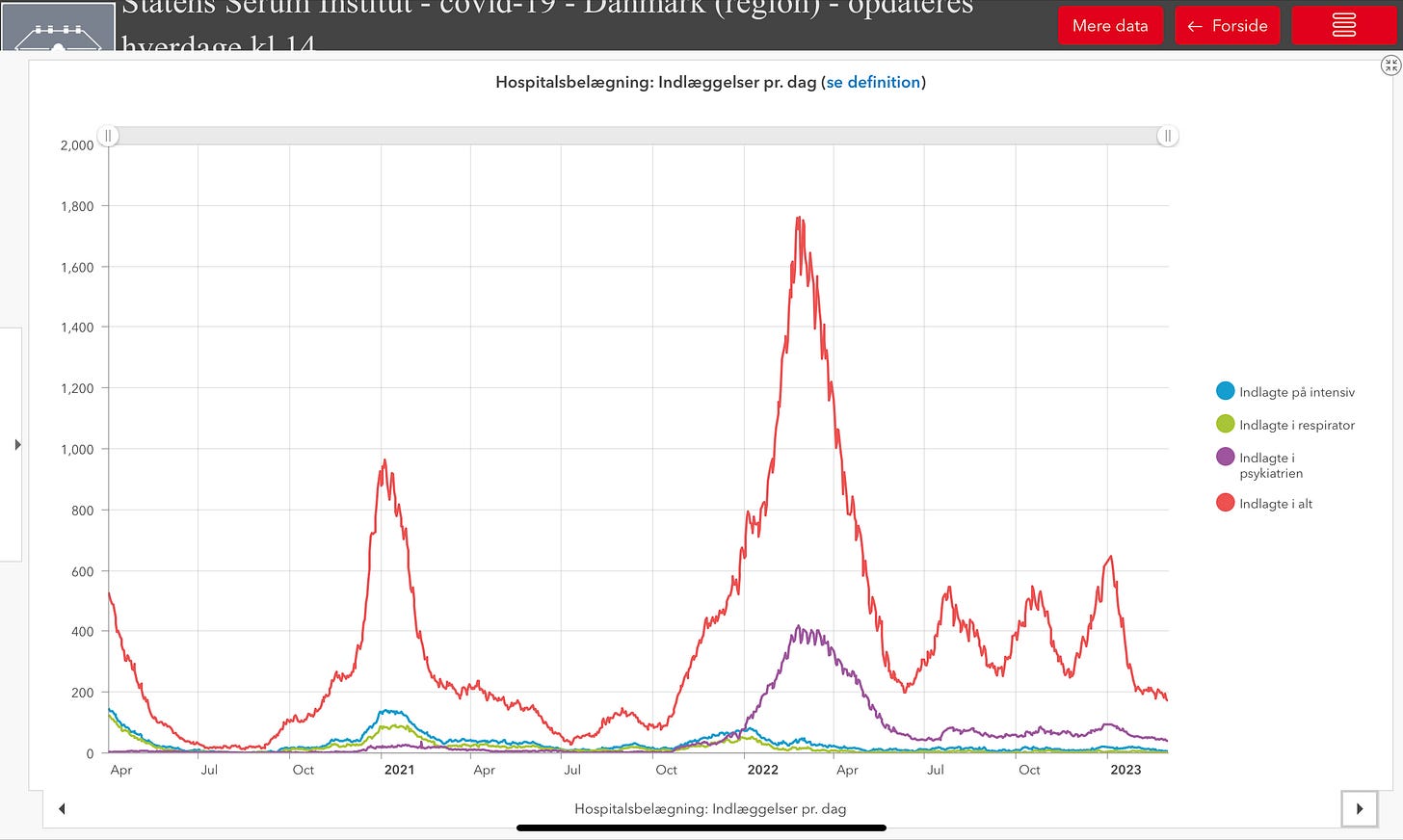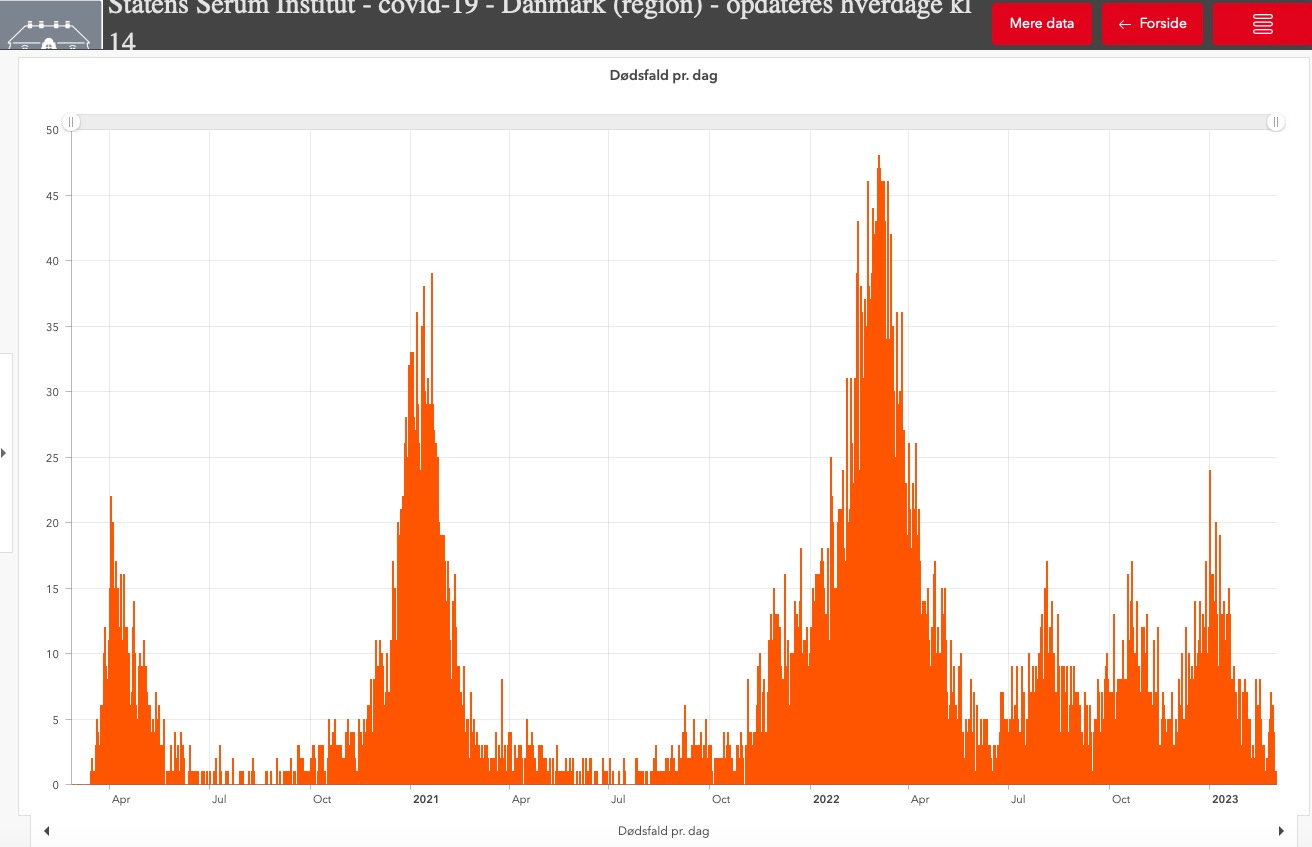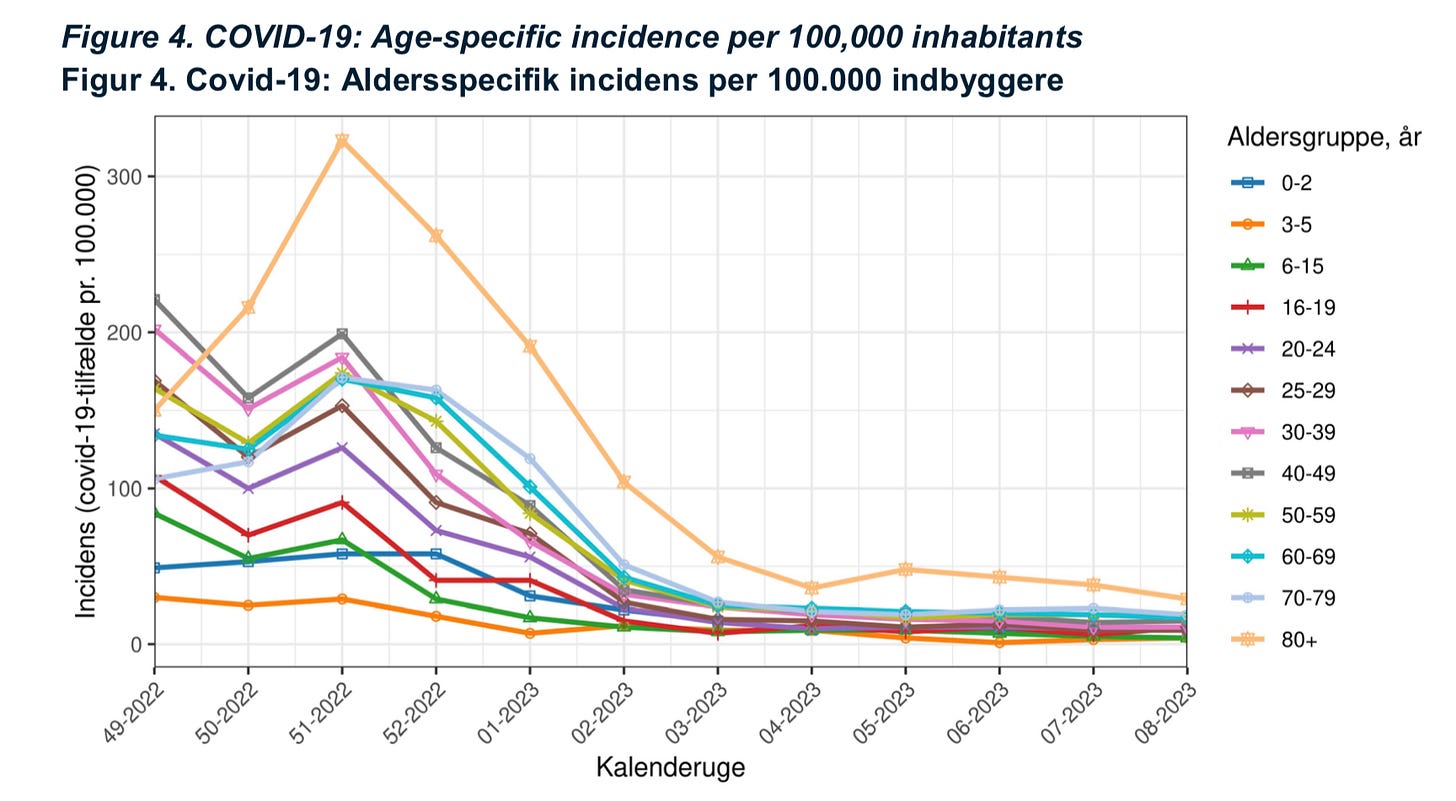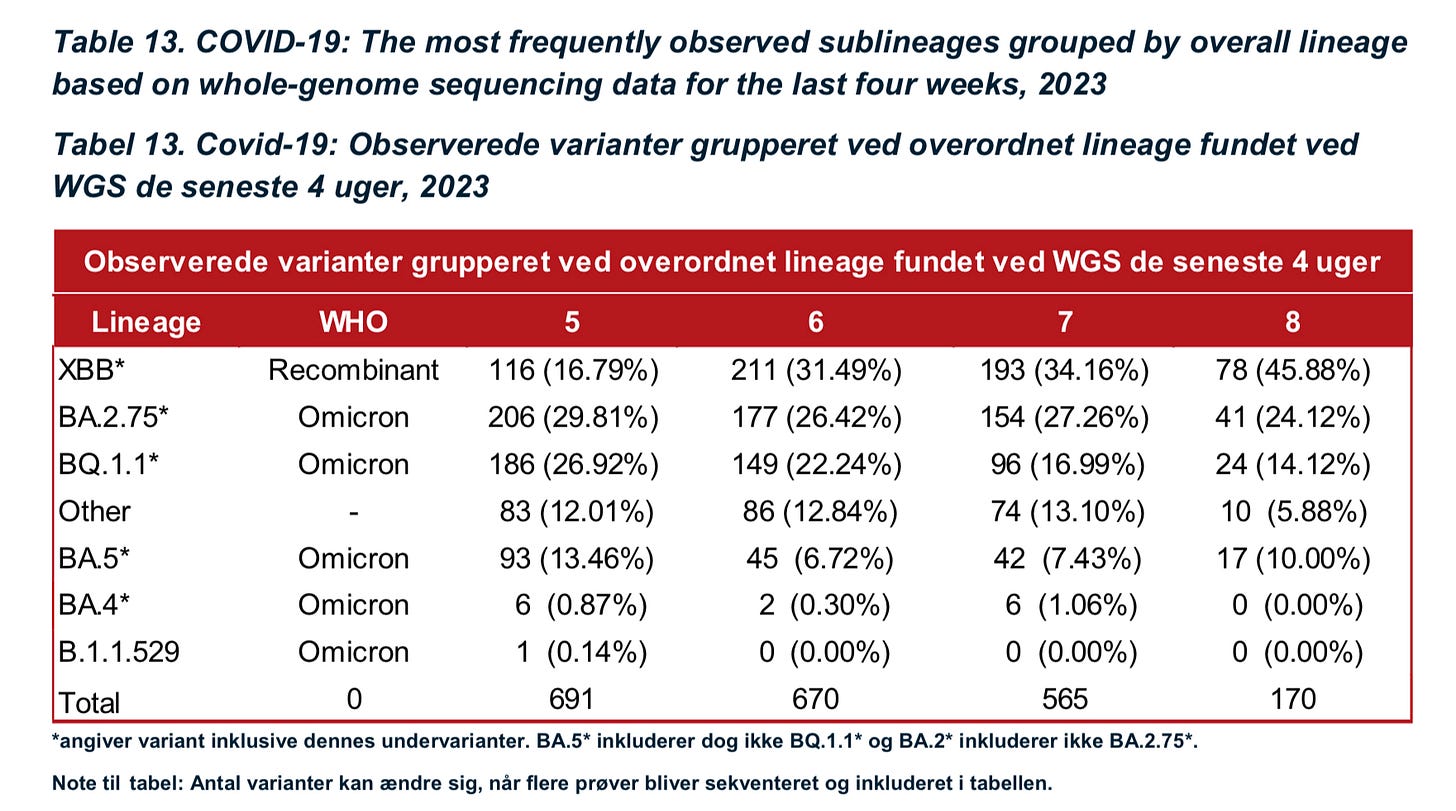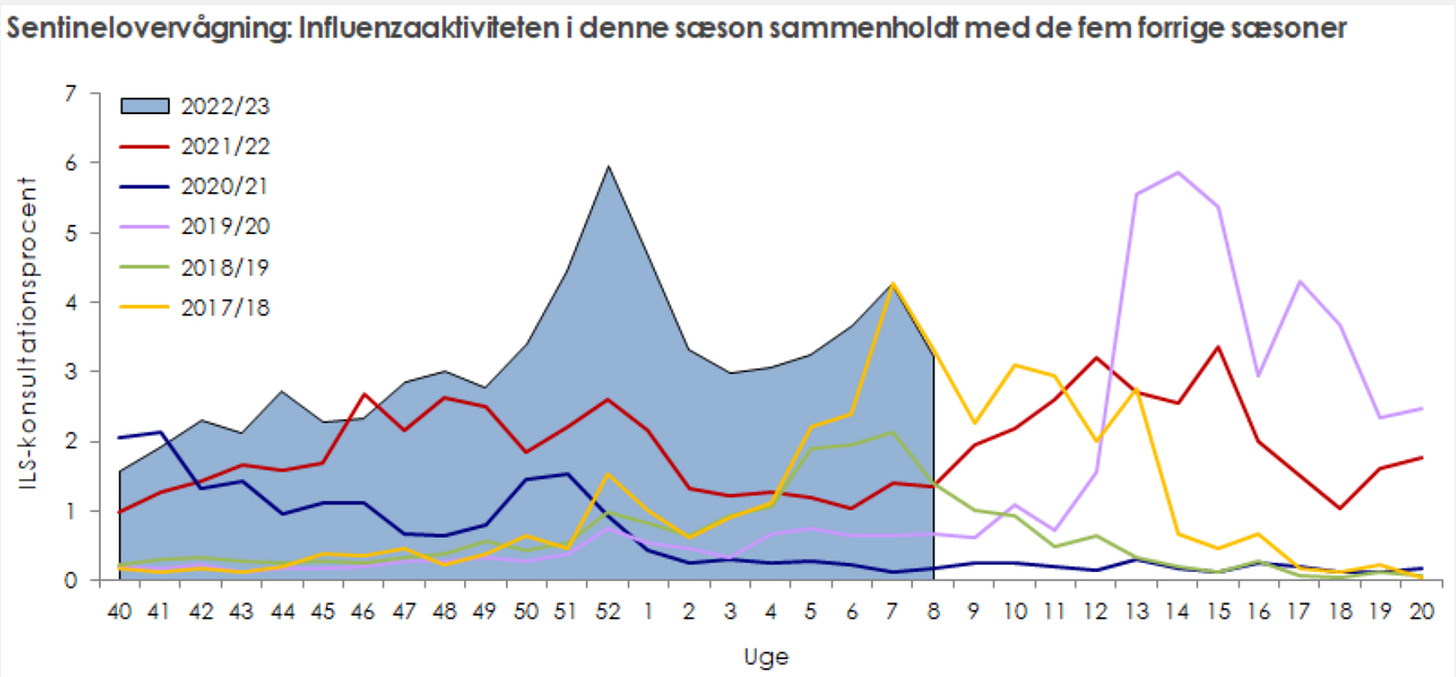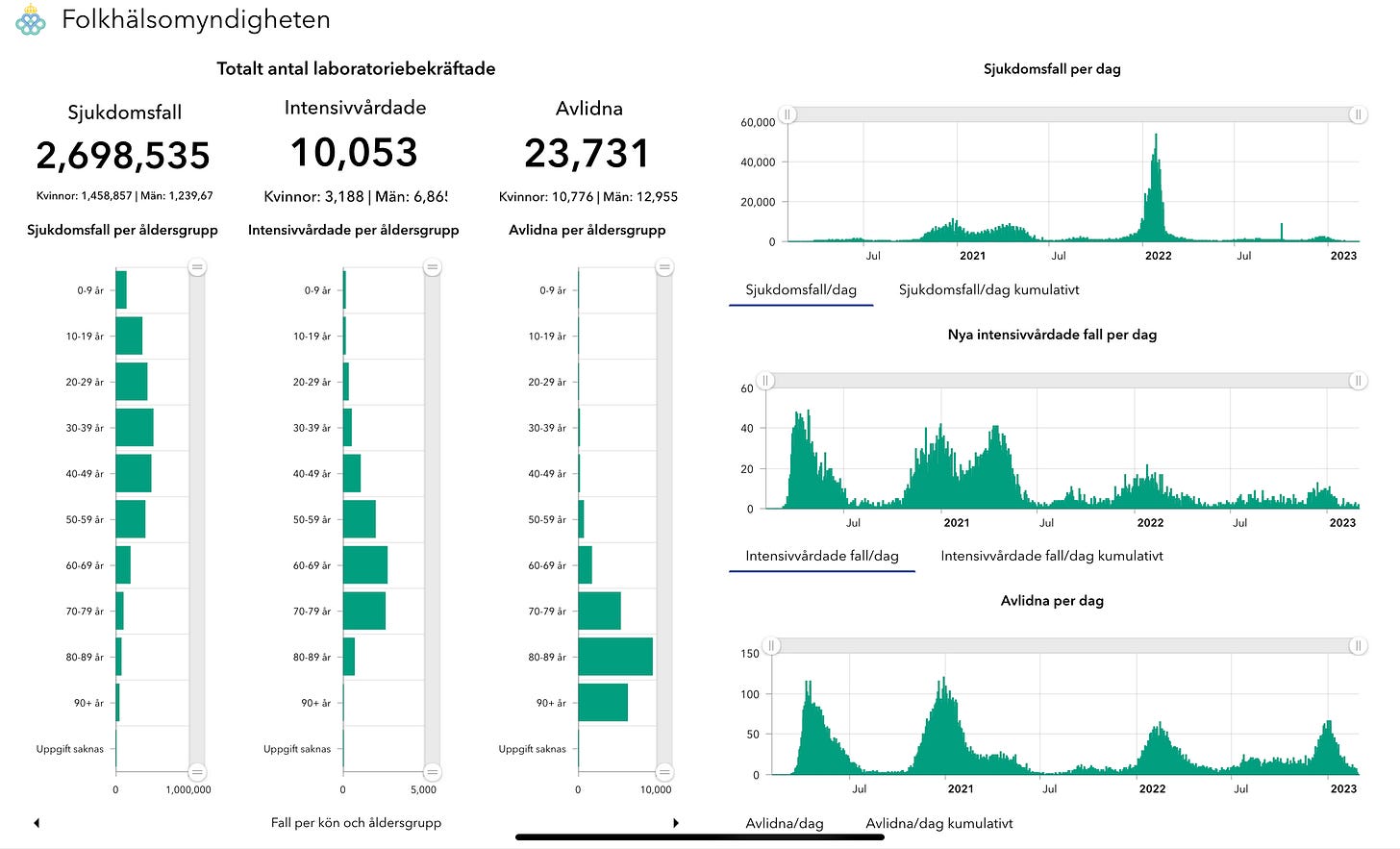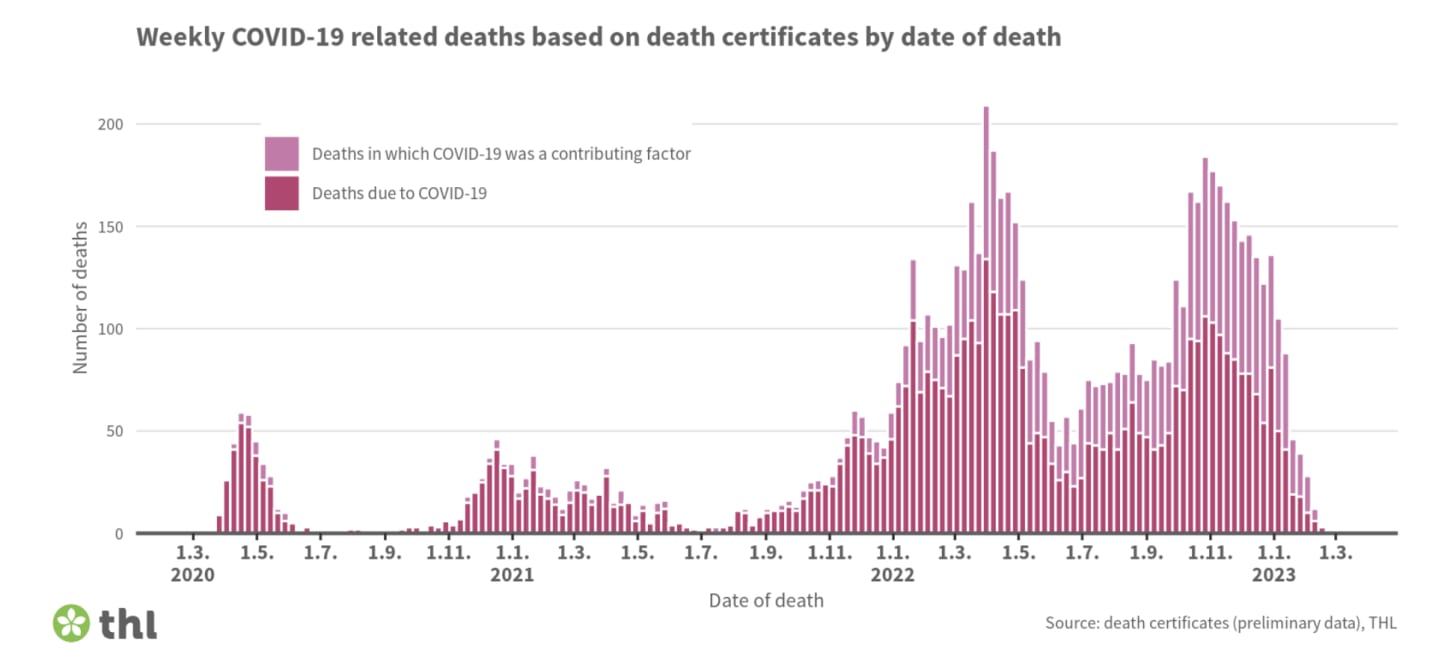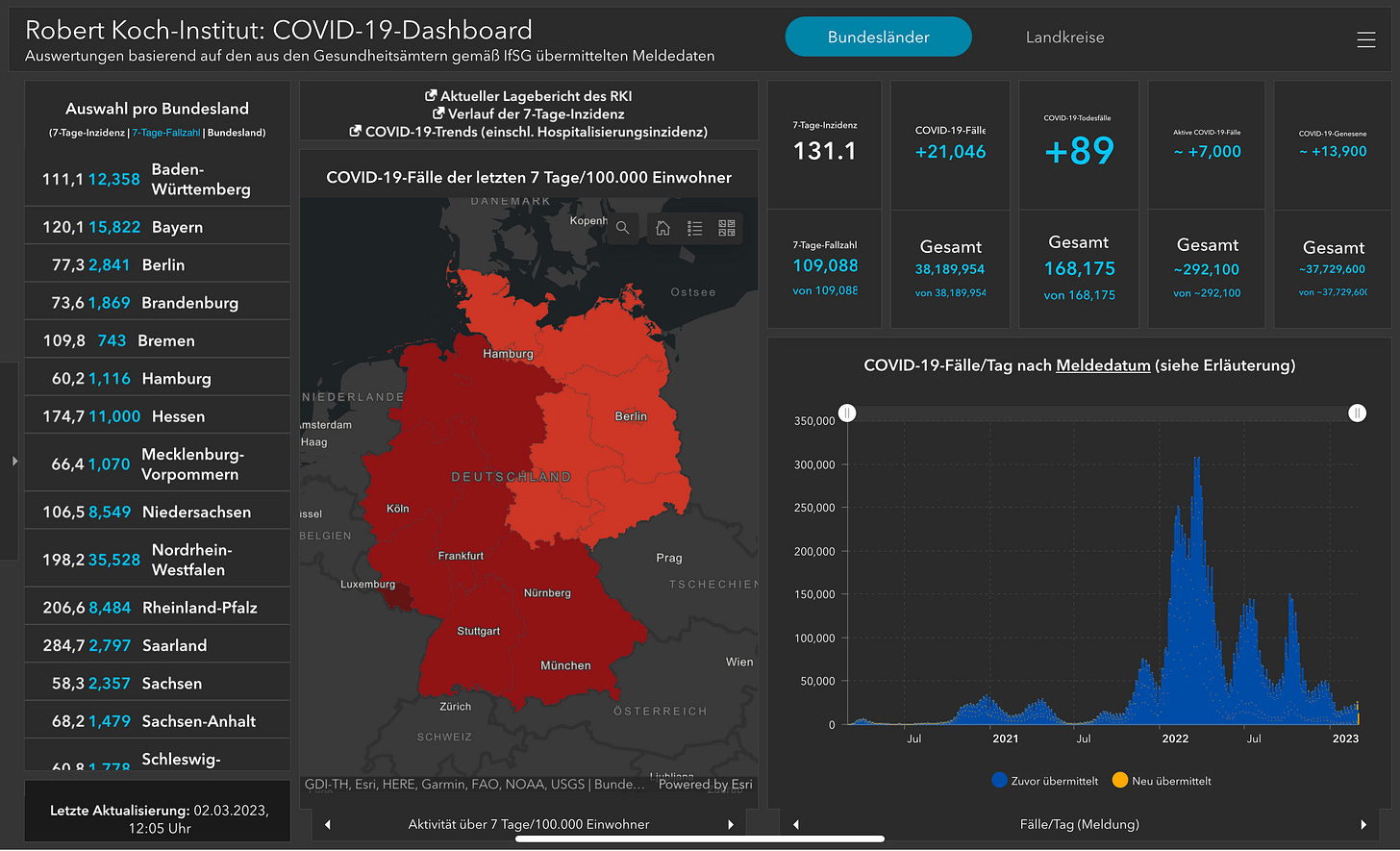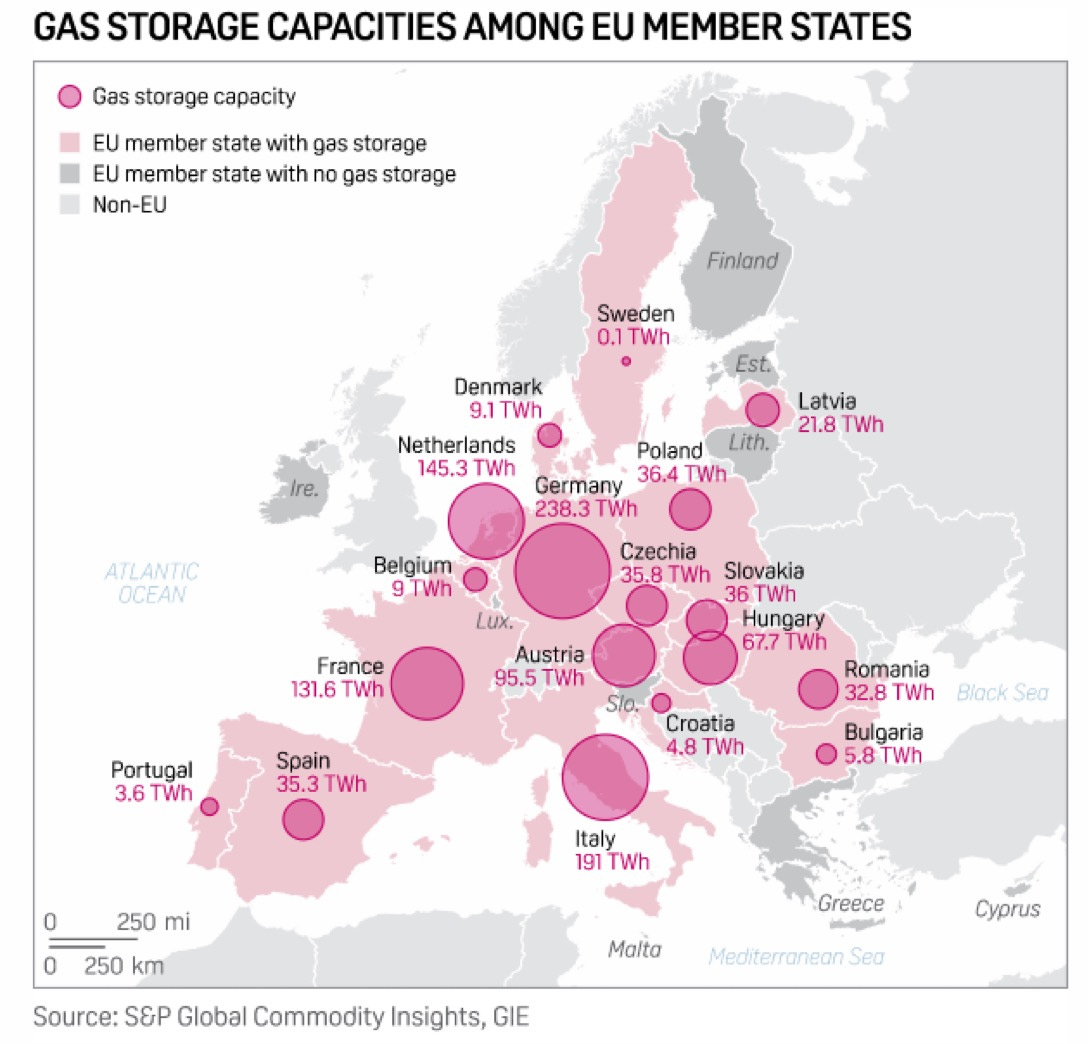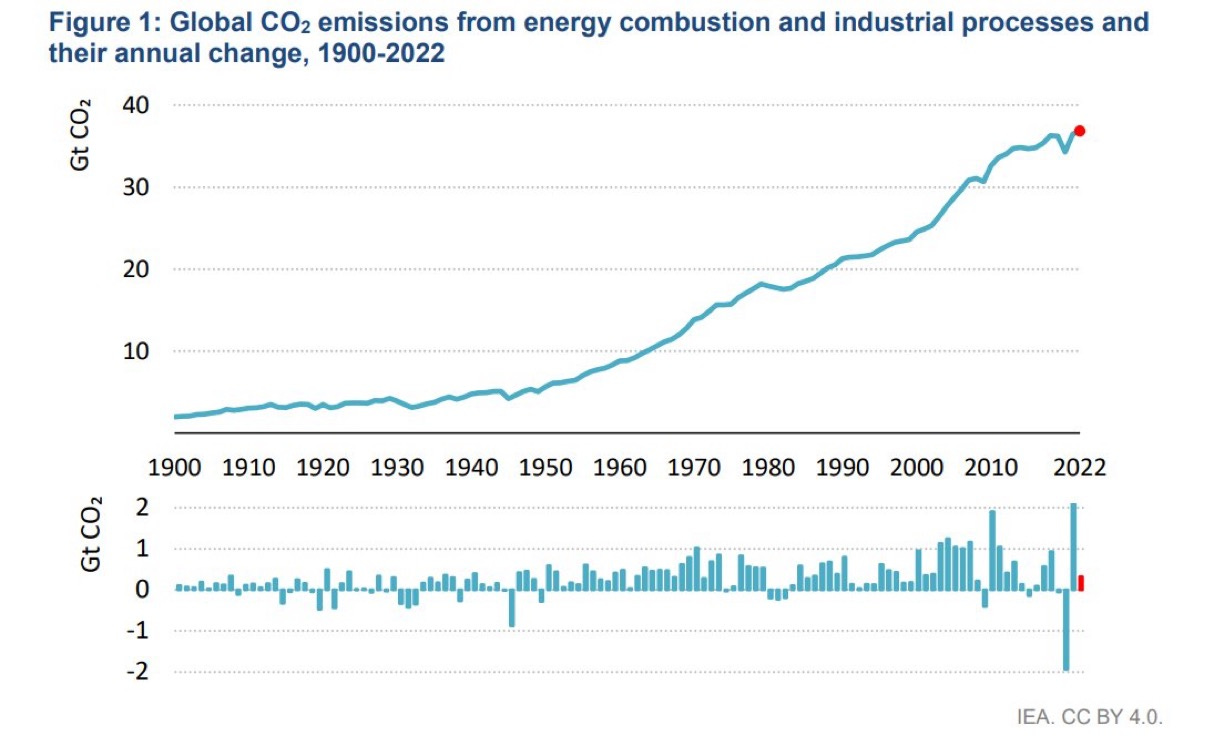The Evening Report - Mar 2
Vaccine season over in Denmark. Europe has dodged the energy crisis bullet, for now.
🦠Pandemic🦠
🇩🇰
“There is no longer a basis for categorizing COVID as a generally dangerous disease in Denmark.”
The Danish National Health Board is seeking to remove the designation that COVID is a “alment farlig sygdom” or a “generally dangerous disease.” Under the Danish Epidemic Act, this is one of three designations, each of which allows for certain actions to be taken to contain an outbreak. The most serious of which is the designation of “socially critical disease,” which the coronavirus was downgraded from in the spring of 2022.
The health board cites fewer infection numbers, effective updated vaccines, and other new medications to blunt severe infections in seeking to remove COVID from the ‘generally dangerous disease’ list.
Director Søren Brostrøm:
“It is very gratifying that COVIiD no longer meets the criteria for being generally dangerous because it reflects that the disease no longer poses a significant threat to society. It is important to remember, that the virus is still among us, and there will continue to be a need to prevent severe COVID infections. In the future, this will happen in line with how we deal with other infectious diseases, such as influenza.”
COVID vaccines, specifically the new bivalent formulas targeting specific variants, are key to minimizing the threat from the coronavirus, according to the health board.
“The virus itself has changed with the Omicron variants, but it is still very contagious and can cause many infections. It is therefore particularly important to our assessment that we have a towering vaccination adherence in Denmark.”
It is expected COVID will no longer be classified as a ‘generally dangerous disease’ in Denmark by April 1.
Sundhedsstyrelsen says it can easily reapply the designation if a new, more dangerous variant emerges that can do an end run around vaccine-induced protection.
-
“The vaccine season is over.”
As of March 1, the Danish Health Authority says that COVID booster doses and influenza vaccinations have ended, at least for now. Since the booster dose and flu shot campaign began in mid-September, the agency says there has been plenty of opportunity for people to get vaccinated. However, anyone still missing their first two coronavirus vaccine doses, or their first booster, can still get them. COVID vaccination is also available based on a doctor’s assessment that a person requires one, for example, anyone receiving an organ transplant or who is immunocompromised.
The five Danish regions are responsible for providing any vaccinations as deemed necessary.
Section Leader Kirstine Moll Harboe:
“Spring is here. Therefore, we are now rounding off this season's vaccination efforts against COVID and influenza. We have seen a very high level of support for the seasonal vaccination program during the autumn and winter. Therefore, the vast majority will be well protected against any minor COVID outbreaks in the coming months.“
But, the vaccination effort isn’t over as much as it is taking a summer break. The health authority says COVID booster doses and influenza vaccinations will be available again this fall. Currently, the Danish regions, the health board, and the Statens Serum Institute are working together to plan for the new vaccination campaign to come.
“Of course, we continue to follow the epidemic closely and will be ready with any vaccination recommendations should the need arise.”
-
There was a slight decline in COVID hospitalizations last week, according to the latest weekly pandemic assessment from the Statens Serum Institute. There were 181 new admissions, ten fewer than the week prior. Ten of those admissions were vulnerable seniors in care. Seniors 70 to 89 years old continue to make up the most significant proportion of new admissions.
Meanwhile, daily COVID hospitalizations (174) crept upward just a little (+1) while the number of severely infected people in an ICU (5) inched downward (-1). Of those, the number of people on a ventilator (2) is unchanged day to day.
The number of infection-related admissions to a psychiatric facility (41) nudged upward (+1).
-
Denmark added another 22 pandemic deaths last week, down from the previous week’s 29. Seven of those lives that were lost were seniors in care.
In the daily update on Thursday, three more lives were lost to the virus, pushing the total death toll in Denmark to 8,272 lives lost.
-
After three weeks of seeing increasing virus activity, followed by a few weeks of stable levels, COVID wastewater surveillance shows no significant change from one week to the next.
-
Turning to the much less reliable pandemic indicators. Infection numbers decreased slightly from week to week. But, at the same time, low PCR testing numbers also continued to drop, down another 12% last week. The COVID incidence rate per 100,000 people eased slightly last week, going from 14 to 13.
The positivity percentage went in the other direction, rising slightly from 8.4% to 8.8%. People 50 to 59 years old registered the highest positivity percentage, at 12%. While seniors over the age of 80 had the highest infection rate (29 per 100,000).
Among high-risk seniors in care, the number of coronavirus infections dropped week to week, going from 45 to 14. The positivity percentage decreased to 5.1%, down from 8.6% the week before.
-
As PCR testing rates drop like a rock, it means that Denmark is increasingly blind to infection trends and the COVID variant situation. From what few sequenced positive tests are being done, the SSI says XBB recombinant variants, Chief among them XBB.1.5 (38%), were dominant in Denmark, making up 45.88% of sequenced positive test results last week. BA.2.75 seems to be seeing its growth level off. While. BQ.1.1 appears to be dissipating.
-
Excess mortality rates have returned to “expected levels,” even among elderly seniors in Denmark, according to the Statens Serum Institute. The institute now says previous reports of excess mortality in the last few weeks in older age groups have been incorrect due to an error in the calculation methodology. It says there haven’t been any excess deaths above average among elderly seniors since the last week of January.
Senior Physician Bolette Søborg:
“We had wondered what was behind the increased in mortality among elderly seniors 85-year-olds and older, as excess mortality rates had fallen for all other age groups. So we are naturally very happy that we have now found part of the explanation, and this means that there is no longer excess mortality among our oldest citizens. The corrected decline is now in line with trends in the other age groups, which were back at the expected level earlier in the year.”
-
The Statens Serum Institute’s sentinel monitoring system indicates that influenza is now Denmark’s most commonly detected respiratory virus. Influenza, adenovirus, and other coronaviruses (not COVID) were the three most detected respiratory viruses last week.
Influenza infections and related hospitalizations continued to ease last week. The SSI notes that influenza B accounts for more infections while the A strain makes up the most flu-related hospitalizations.
RS virus infections and hospitalizations continued to retreat last week.
🇪🇺🦠
One less possible COVID tablet treatment available in the European Union. The European Medicines Agency is no longer recommending the use of Lagevrio, the brand name for the anti-viral medication molnupiravir, for treating COVID patients. The European pharmaceutical watchdog group has examined all the data and determined the treatment “does not have the expected effect.”
🇩🇰 🦠
Danish health authorities were quick to react to the EMA decision on Lagevrio.
Danish National Health Board Senior Physician Kirstine Moll Harboe:
“We have been waiting for the final assessment from the European pharmaceutical authorities. Now the EMA has rejected the medicine, and we will therefore no longer recommend that Lagevrio be used in Denmark. We notice that the lack of approval is not due to any safety problems but rather that there is a lack of data proving it has the desired effect.”
Denmark will continue to lean heavily on the Paxlovid COVID tablet treatment for those considered to be high-risk. In fact, the health board is now expanding eligibility for Paxlovid treatment.
“We have reviewed the studies that have examined the effect of Paxlovid, and we can see that Paxlovid reduces the risk of severe infection, even if you are vaccinated. That is why we are now expanding the target group so that more people will have the opportunity to receive treatment.”
The Danish Health Authority published an updated professional guidelines for the doctors who prescribe Paxlovid.
To be eligible for Paxlovid, one must have a proven coronavirus infection with a positive PCR, rapid test, or via a self-testing kit:
The person is considered to be at increased risk of a severe infection
The person has significant coronavirus symptoms
The treatment is recommended by a doctor.
All elderly seniors over the age of 80
Anyone 18 to 79 years old and older with at least one underlying health condition putting them at risk of a severe infection.
🇪🇺/ 🇩🇰
A pandemic recovery fund approved by the European Union is still doling out hundreds of millions of euros. Denmark will get another 2.2 billion Danish kroner from the fund in April (about $420 million Cdn). The money will be used to help Denmark transition to green energy. It will also help fund a new IT system to help doctors report any COVID vaccine side effects.
🇸🇪
Sweden has added 708 infections (wildly underreported) and another 69 virus deaths in the last seven days.
COVID hospitalizations (458) continue to ease (-26) while intensive care numbers (6) have also decreased (-4).
82.1% of seniors 65 years old and older have a 2nd booster dose.
-
The Swedish Public Health Agency is now recommending that vulnerable seniors over 80 and those in senior care homes get another COVID vaccine booster dose. The revaccination campaign began on March 1.
Region Stockholm Vaccine Coordinator Leyla Jalilian:
“As always, vaccination activities are adapted to the situation we are in. The Public Health Agency now recommends new booster doses but only to those groups that need to strengthen their protection due to their age or other risk factors. During the spring, it is people who are 80 or older and people who live in special housing for the elderly who are recommended a top-up dose.”
Region Stockholm says it is beginning to notify those eligible for another dose of vaccine so they can book a vaccination appointment.
-
The Swedish Government is donating 722,200 doses of the Pfizer/BioNTech COVID vaccine to the global vaccine initiative COVAX.
Minister for International Development Cooperation and Foreign Trade Johan Forssell:
“Our support to COVAX is saving lives and creating conditions for good health in a number of countries. Sweden’s donation will enable people in low and middle-income countries to receive booster doses of the same type of vaccine being used in ongoing Swedish vaccination campaigns.”
The COVAX initiative provides COVID vaccine doses to poor and developing countries. In low-income countries, vaccination rates, even for just the first two doses, has yet to hit even 30%.
Sweden says it is standing by to donate even more doses “to countries with the capacity to vaccinate their population.” It also assures people in Sweden that donating the doses doesn’t impact vaccination efforts in Sweden.
🇫🇮
Finland registered 807 infections and 44 more corona deaths in the last seven days.
-
There will not be another round of COVID booster doses this spring in Finland. The Finnish Institute for Health says there is no need for another jab because existing vaccination protection is good enough for most of the population. The one exception is people who are immunocompromised. They will get another booster dose if their doctor recommends it.
The health agency described the current pandemic situation as “calm.” It says hospitalizations are falling, as are pandemic deaths. It also banking there will be no new infection wave arriving this spring.
Chief Physician Hanna Nohynek:
“However, we are constantly monitoring the epidemic situation, the need for hospital treatment of different age and risk groups, and deaths. Those who have taken a booster dose have fresh immune protection, so a new booster dose in the spring would not give them a significant additional benefit in preventing severe coronavirus infection.”
However, the institute is already planning for another round of booster doses beginning next fall. It is currently developing a strategy to decide who should get a 5th dose.
“We are considering, among other things, whether the next round of booster doses would be for the elderly and those belonging to high-risk groups. The COVID vaccine could possibly be given again together with influenza vaccinations.”
-
More than half of the Finnish population has hybrid immunity protection offering a solid shield against severe COVID infections. Hybrid immunity is the antibody protection created by having had an infection and being vaccinated. A Finnish Institute for Health study estimates 51% of the population was covered by hybrid immunity by the end of 2022.
It concluded after launching a study involving randomly selected people across the country. The research included blood samples taken from almost 9,800 people.
By age, young adults had the highest level of hybrid immunity, with 71% of 18 to 29-year-olds having had an infection and at least two vaccine doses. For children under 12, hybrid immunity covered an estimated 77%. For kids 12 to 17 years old, it was 81%.
Research Manager Merit Melin:
“In Finland, COVID infections only started to rise when the vaccination coverage of young people and adults was already high. Although vaccines have not been able to prevent infections caused by new variants, they have provided protection against severe infections for a large part of the population. Infections strengthen protection against severe cases of coronavirus even more.”
The study also determined that infection activity covered about 7% of the population until the end of 2021; after the Delta wave receded and the Omicron variant arrived, it rose to 31%. When more immune-invasive variants began to drive infection waves at the end of last year, infection activity covered an estimated 54%.
🇳🇴
Respiratory infections in Norway have “decreased significantly” and are now in the same neighbourhood as the average pre-pandemic winter numbers. But, there are signs of potential trouble ahead.
In its latest weekly pandemic snapshot, the Norwegian Institute of Public Health says coronavirus activity is now at “a low level.” But, it warns that after seeing increasing levels of virus activity in wastewater surveillance, COVID hospitalizations have risen again. The agency says this might be a sign of another arriving infection wave. It notes that Omicron BA.2 sub-variants are becoming dominant as the Ba.5 strain fades. It notes this trend “has resulted in an increase in infections in some other countries.”
The number of influenza cases has increased again in Norway after seeing dropping case numbers in the two weeks prior. The NIPH says it is seeing more flu cases from the B strain. The institute says it remains to be seen if this will or will not translate to another spike in flu activity.
The good news is that after suffering three simultaneous infection waves over Christmas, Norway is seeing RS virus infections continue to recede. Cases are down across the board, as are infection-related hospitalizations.
“Hospitals and municipalities must be prepared that the flu epidemic may last a few more weeks and that there may be a new wave of COVID infections and admissions during the spring.”
The NIPH is urging people to get vaccinated especially against influenza as it protects against the influenza B strain, which is on the rise. The health agency advises people to stay home if they feel sick; if they have symptoms, then mask up around other people; vulnerable and high-risk groups should be diligent with their mask use, and it also reminds people to use good cough and hand hygiene.
🇩🇪
Germany recorded 21,046 new infections and 89 more pandemic deaths in its Thursday report.
It added another 1,772 COVID hospitalizations while ICU numbers (1,031) dipped (-19). As a percentage of all intensive care beds in the country, coronavirus patients are using 4.8%.
🇭🇰
Hong Kong has lifted its mandate for people to wear COVID masks in all public spaces. It was one of the last major cities in the world to enforce a mask mandate still. The restriction, which had been in place for 959 days, was officially repealed on Wednesday. The city says it is “returning to normal.”
⚡️Energy Crisis⚡️
🇪🇺
Unseasonably warm winter temperatures have again helped Europe fight through another week without struggling with any energy shortfalls. European Union natural gas reserves eased to 62.5% last week, compared to 64.1% the previous week. But, we are not out of the woods yet as a late cold snap is rolling across Europe, which will increase heating demand and draw in Europe’s gas reserves. Beginning this week, temperatures across Europe will average 2 ° C below seasonal norms.
Three countries have now seen gas reserves slip below 50%, with France (44%) having the lowest gas reserves of any EU country. Trailing not too far behind are Romania (47.8%) and Hungary (49.6%). While Belgium (52%) is nearing the halfway mark. Spain, Germany, Austria, Poland, and Bulgaria have 70% or greater gas reserves.
Overall, the Netherlands has managed to conserve the most gas in Europe, with a nearly 30% reduction in gas use compared to the seasonal average. While other countries like Germany and Spain struggle far more to get the energy conservation message across.
Germany has hit the EU goal of a 20% reduction in natural gas use in just two of the last five weeks, including last week, when it achieved a 22.7% reduction. But the warmer weather and less heating demand provided a big helping hand. Temperatures across Germany last week were, on average, 2.7 ° C warmer.
-
Inflation in the Eurozone declined last month, but it didn’t drop nearly as much as forecast. Inflation in the European Union was 8.5% in February, down just slightly from January’s 8.6%. Economists in Europe are calling February’s number “disappointing.” The European Central Bank is expected to increase interest rates when it meets later this month.
🌍
The energy crisis is driving increasing CO2 emissions, in part due to leaning more heavily on polluting fossil fuel energy sources. One of the silver linings of the COVID pandemic in 2020 was a global reduction in greenhouse gas emissions. But the energy crisis is now having the opposite reaction. Global CO2 emissions rose by 6% in 2021 and have now continued to increase, hitting an all-time high, according to the International Energy Agency.
The IEA says a significant reduction in fossil fuel-driven emissions is necessary to limit global temperature increases and prevent severe climate change impacts.
Agency Head Fatih Birol:
“We are still seeing growing emissions from fossil fuels, which are hindering efforts to reach the world's climate goals.”
While emissions rise and fossil fuel producers reported windfall profits last year, there is also some good news. Emissions are being offset to some degree by an increase in renewable energy sources as the energy crisis puts rocket boosters on efforts to transition to green energy. The IEA says the rise of renewable energy sources like wind and solar prevented an additional 550 million tonnes of greenhouse gases from being emitted.
🇪🇺🇸🇪
The energy crisis battle has been won, but the war is far from over. That is, in essence, the message from European Union Energy Commissioner Kadri Simson this week.
“Today, we can say that Russia’s energy blackmail has failed. The EU has successfully made it through the winter despite Russia’s attempts to disrupt its gas supplies, but there is still a lot of work needed to protect future energy security; by many standards, Europe is now more energy secure, less dependent [on] Russia and stronger than it was a year ago. But the test is not over. We have just won the first battle, and there is still a long fight ahead of us.”
But there is no room for complacency. Speaking to EURACTIVE, Sweden’s Energy Minister Ebba Busch says there is still much work to do on energy security.
“It is clear that Europe has made enormous progress in managing gas supplies since the start of the war. But one conclusion is clear. It is not over yet, and next winter will bring new challenges. The supply needs to be secured as soon as possible to avoid extreme gas and electricity prices and, worse, a gas shortage.”
Sweden currently holds the EU’s rotating presidency.
🇩🇰
As Europe looks to have dodged the energy crisis bullet, at least for this winter, there are signs of a return to normal in Denmark. With possible energy shortfalls top of mind last fall, energy conservation was the name of the game. But, community centers and swimming pools are beginning to turn up the heat and reactivate saunas and steam rooms. The Danish Energy Agency is cautiously signaling that the risk of energy shortfalls is now low.
-
Energy prices in Denmark have returned to normal after soaring over the winter due to the energy crisis. At its height, electricity prices exceeded eight kroner per kilowatt hour (over $1.55 Cdn), but are currently back below 2 kroner KWh (around 30 cents Cdn). But, while soaring prices have returned to earth, people in Denmark continue to reduce their energy use.
Energy company Norlys says its customers used 13% less electricity in January of this year than January of 2022. It was a similar story for NRGI, which saw a 10% reduction. This is despite very similar electricity prices year over year.
Norlys Customer Service Head Pernille Storgaard spoke to DR:
“This shows that we have stuck to good habits. Customers are interested in what are the biggest energy guzzlers in their household and how they can save as much electricity as possible.”
People should also continue to keep a close eye on electricity prices.
Green Energy Denmark Chief Consultant Kristian Rune Poulsen also spoke to DR:
“The price drop seems to be starting to stop now, and then the electricity price is at the level we have now. It is around one krone per kilowatt hour when it is not windy, and then slightly lower when it is windy, or the sun is shining.”
In Denmark, renewable energy production largely comes from wind and solar, making the country very dependent on the weather. So prices will continue to fluctuate.
“You can still save money by shifting power consumption by, for example, starting the dishwasher at night. If you have an electric car, you consume a lot of electricity, so there is even more money to be saved by being a flexible consumer.”
🇸🇪
Sweden’s GDP dropped by 0.9% in the fourth quarter of 2022, a drop much larger than many experts in the country expected. Statistics Sweden says that many areas of the Swedish economy have seen declines.
🇩🇪
The energy crisis is pushing Germany’s economy into a recession, and the effects on some segments of the economy are becoming dire. Chemical giant BASF is blaming soaring costs due to the energy crisis as it announced that it will cut 2,600 jobs in Germany this week. The company says it paid almost €4 billion in additional costs when the energy crisis drove prices through the roof.
🇺🇦/ 🇷🇺 War
🇫🇮/ NATO
NATO Secretary General Jens Stoltenberg and Finnish Prime Minister Sanna Marin held a joint press conference this week in Finland. Stoltenberg said that when the war in Ukraine is over, it must also bring an end to Russia’s opportunities to attack its neighbours.
“No one can say exactly when the war will end. But when it does, we must make sure that history does not repeat itself.”
Stoltenberg says the key to bringing Russia to heel is to keep building up Ukraine’s military see it join the European Union and eventually NATO.
For her part, Marin, responding to questions, said that both Finland and Sweden had fulfilled every criteria to become full members of NATO. She says she hopes is that both Nordic nations will become members of the military alliance by this summer. On that note, she urged Hungary and Turkey to hold ratification votes as soon as possible. Turkey continues to drag its heels as it tries to use the situation to pull every concession it can out of Sweden and Finland. The three countries will resume negotiations in Brussels in mid-March.
When asked why Finland wants to join NATO, Marin responded, in part, because it would improve her country’s security situation.
“NATO is a line that not even Russia is willing to cross.”
Marin also seemed to be at a loss regarding Hungary’s sudden shift to a more critical stance on Finland and Sweden’s NATO membership. Hungarian politicians have suddenly taken issue with criticisms from Finland over the state of Hungary’s democracy. At the press conference Marin reiterated that Hungary has repeatedly assured Finland they support their inclusion into NATO. When asked how she feels about the state of democracy in Hungary, Marin danced around an answer, saying in essence, that the rule of law is vital for a thriving democracy, and it is a high priority for Finland.
-
The Finnish parliament isn’t waiting for Turkey and Hungary to decide on the country’s NATO application. Parliamentarians voted overwhelmingly to approve the legislation required to join NATO. 184 voted for, seven opposed, and seven abstained.
This removes any legislative hurdles from the Finnish side. Should Turkey and Hungary eventually vote ‘yes,’then Finland will be able to become a NATO member more or less immediately.
🇭🇺/ 🇸🇪 🇫🇮
The games continue in Hungary as it follows Turkey’s lead. The country’s parliament has again delayed the ratification vote on Sweden and Finland’s NATO applications. Reuters is reporting that Hungary’s ruling party, Fidesz, supports the Nordic nations applications. But, other Hungarian political leaders are again citing criticism from the two Nordic countries over the rule of law and the state of democracy in Hungary. Earlier this week, Hungarian Foreign Affairs Minister Peter Szijjarto said that Sweden and Finland should not expect a quick ratification process from his country. Turkey and Hungary are the only two of NATO’s 30 member nations that have yet to hold a ratification vote.
🇫🇮/ 🇷🇺
Finland has begun building a sprawling fence along part of its border with Russia. Work on the huge project started on Wednesday and will take the next three or four years to complete. The fence will cover just 200 kilometers of the 1,340-kilometer-long border between the two countries. The current border fence was originally designed to keep livestock from crossing from one country into the next. With Russia’s invasion of Ukraine, the new fence is aimed more at preventing human incursions than animals. It will be three meters high and topped with barbed wire.
🇱🇹 🇱🇻 🇪🇪 🇵🇱/ 🇷🇺 🇧🇾
Finland is not alone, as the Baltic states, Latvia, Lithuania, and Estonia are also increasing security along their borders with Russia. Poland is taking it one step further as it is not only adding fencing along its border with Russia, but also fortifying border crossings with barricades and anti-tank obstacles. It also plans to extend increased border security and fortifications along its borders with Belarus.




